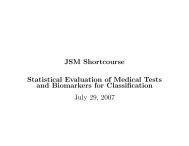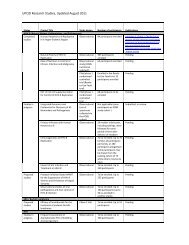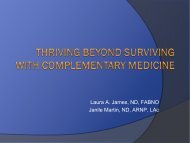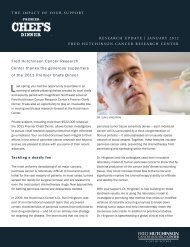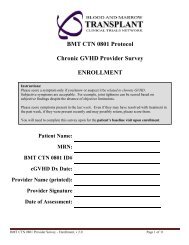Summer Undergraduate Research Program - Fred Hutchinson ...
Summer Undergraduate Research Program - Fred Hutchinson ...
Summer Undergraduate Research Program - Fred Hutchinson ...
You also want an ePaper? Increase the reach of your titles
YUMPU automatically turns print PDFs into web optimized ePapers that Google loves.
Impact of Meal Frequency on Glucose Patterns<br />
Aisha G. Kudura¹, Yvonne Schwarz², Johanna W. Lampe² ³, Marian L. Neuhouser² ³<br />
¹New Mexico State University, Las Cruces, NM; ²<strong>Fred</strong> <strong>Hutchinson</strong> Cancer <strong>Research</strong> Center, Seattle, WA;<br />
³University of Washington, Seattle, WA<br />
Study Design Results<br />
Background<br />
Analysis included data from 8 participants. We used Area Under the<br />
Curve (AUC) to analyze the blood glucose data. Although no significant<br />
Many popular weight-loss diets today have suggested that frequent<br />
eating, or grazing, might be beneficial for weight loss. However it is<br />
difference was observed between the AUC during the grazing pattern<br />
and the three-meals-a-day pattern (p=.570), AUC glucose was slightly<br />
unclear what effect this eating pattern may have on glucose and insulin<br />
regulation. Eating frequently throughout the day keeps the body in a<br />
higher (about 2%) during the grazing pattern.<br />
Characteristic N %<br />
Sex<br />
Male 3 38<br />
Female 5 63<br />
Race<br />
White 6 75<br />
African American 2 25<br />
2010 Best Poster Award<br />
postprandial metabolic state, preventing glucose levels from reaching<br />
the between-meal nadir that allows for secretion of the counter-<br />
Interestingly, standard deviations were quite a bit higher for the grazing<br />
pattern (Average AUC SD Grazing=7.03, Average AUC SD<br />
regulatory hormone network.<br />
Characteristic Mean SD<br />
Meal=3.95), suggesting that the glucose excursions were more<br />
86.6 10.1<br />
Fasting Glucose<br />
(Baseline)<br />
variable during the grazing pattern.<br />
Pattern Mean<br />
AUC Glucose<br />
SD<br />
AUC<br />
Grazing 23,600 7.85<br />
Meal 22,100 4.71<br />
Chronic exposure to glucose and insulin through frequent eating may<br />
put individuals at risk for carcinogenesis and other health problems, yet<br />
BMI (kg/m²) 29.5 2.9<br />
37.3 10.3<br />
% Body Fat<br />
(Baseline DXA)<br />
few studies have examined the effects of meal frequency on health.<br />
During times of frequent eating, certain cancer-related signaling<br />
pathways (Pl3K-Akt/mTOR) remain up-regulated, increasing the risk for<br />
carcinogenesis.<br />
Results<br />
The Meals and Grazing (MAG) study compared the effect of a 3meal-a-day<br />
eating pattern to a grazing eating pattern on glucose<br />
155<br />
and insulin in healthy, free-living humans.<br />
Methods<br />
HYPOTHESIS: Compared to a standard three-meal-a-day eating pattern, a<br />
grazing meal pattern will be associated with glucose intolerance and risk for<br />
insulin resistance.<br />
DESIGN: Eight participants were invited to join the study. Subjects were<br />
Conclusion & Future Directions<br />
asked to keep a food log of their usual diet for one week. Subjects were<br />
then randomized to begin with either a three-meal-a-day eating pattern or a<br />
The MAG study was a small pilot study examining the impact of meal<br />
frequency on health. The CGMS is a useful device for monitoring blood<br />
¹Includes data for all subjects<br />
FASTING GLUCOSE<br />
grazing meal pattern for two weeks. All subjects were free-living and ate<br />
their habitual foods (same foods as in the 7-day food log) during the study.<br />
glucose in future nutrition or health related studies. Although no<br />
significant difference was found between those who ate three meals a<br />
Pattern Mean<br />
(mg/dL (mg/ dL) SD P value<br />
Intensive instruction was provided from a Registered Dietitian about eating<br />
the same foods for the meal period and the grazing period, but splitting the<br />
day and those who ate eight smaller meals a day, there was a<br />
suggestion that the AUC was larger for grazing than for the 3-meal-a-<br />
Grazing 89.25 4.71 .077<br />
Meal 93.25 7.85<br />
identical foods into three or eight eating occasions per day. In this way, the<br />
same foods and the same number of calories were consumed on each<br />
day pattern. Further research on meal frequency and health needs to<br />
be conducted using a larger sample size. Future studies should also<br />
study arm. After a two-week washout period, subjects crossed over to the<br />
other eating pattern. Subjects wore a continuous glucose monitoring sensor<br />
focus on ways to increase participant adherence to the prescribed<br />
weekly menu.<br />
FASTING INSULIN<br />
(CGMS) three days prior to the end of each eating period (Medtronics®,<br />
Inc., Northridge, CA). T-tests compared fasting insulin and glucose as well<br />
Acknowledgements<br />
Pattern Mean<br />
SD P value<br />
(mg/dL (mg/ dL)<br />
Grazing 6.86 3.28 .382<br />
as Area Under the Curve (AUC).<br />
The MAG study is supported by grant U54CA116847. The summer internship<br />
program is supported in part by NCI grants: 5 U54 CA132381 (FHCRC) and 5 U54<br />
CA132383 (NMSU). Thanks to Medtronics® for the use of the CGMS devices, and<br />
to Dr. Marian Neuhouser and Yvonne Schwarz for the mentorship throughout this<br />
project.<br />
Meal 7.53 2.96<br />
¹Includes data for all subjects<br />
TEMPLATE DESIGN © 2008<br />
www.PosterPresentations.com




